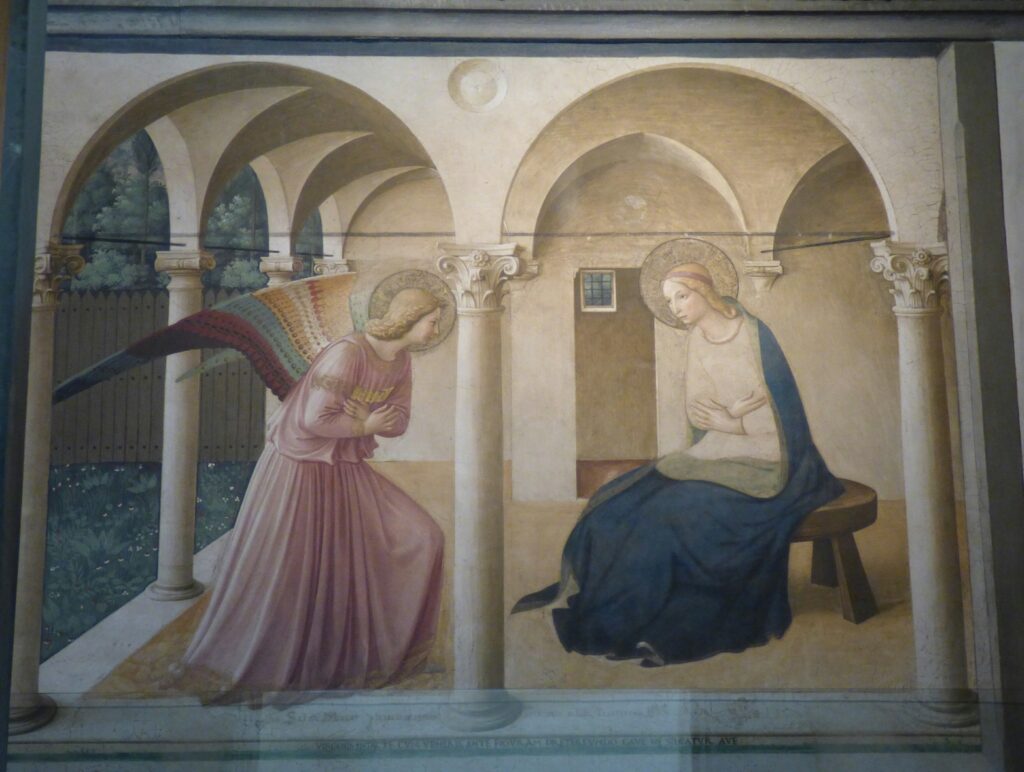A Dominican fresco that preaches
Angelico’s Annunciation sits on my desk, and I look at it daily, pondering its meaning and message. It reminds me of my recent visit to San Marco in Florence and its astonishing sacred art. The Dominicans have a remarkably rich artistic heritage.
Fra. Angelico composed scenes of spiritual intensity, fusing piety and innovation to create opportunities for contemplation and reflection. He pioneered many stylistic trends of the early Renaissance, including the rational treatment of pictorial space and the volumetric modeling of forms with light and shadow, placing himself at the forefront of artistic innovation.
He captures the moment in Christianity when Gabriel appears to Mary and announces she will give birth to the Son of God.
The fresco is large, 230 x 297cm, and is the first image you see as you ascend the stairs to the friars’ cells. Its location makes a dramatic impact. The scene, set under a plastered, bare arcade, reflects the Michelozzo cloisters on the ground floor of San Marco. It is different in mood from previous Annunciation paintings and icons. This artwork does not tell you how to feel; it summons or jolts you into its world. The setting is austere and intimate. Something important is happening, but the angel looks modest and confiding. There are no trumpet blasts, no immediate sense that this angel is an emissary of the Creator.
Fra. Angelico, influenced by Masaccio’s naturalism and the innovative techniques of Brunelleschi and Alberti, has shaped and styled his work to make the mystery of the Incarnation a graspable visual language.
The painting is quiet and understated but bursts with hidden meaning. The Gothic flatness of the work belies its emotional complexity. Depth is depicted by columns receding in size, which Fra. Angelico colours and shades so that they fade into the background.
He embeds rationality and precision by creating illusionistic settings using linear perspective. He works with Michelozzo’s architecture, emphasising the continuity between an actual and a simulated space. Fra. Angelico’s artistic signature of light, with spatial and perspective simplicity, is epitomised in this fresco.
He embeds rationality and precision by creating illusionistic settings using linear perspective. He works with Michelozzo’s architecture, emphasising the continuity between an actual and a simulated space. Fra. Angelico’s artistic signature of light, with spatial and perspective simplicity, is epitomised in this fresco.
The figures of Mary and Gabriel are life-sized, and the location of the fresco means the viewer can read the work very closely. There is no distance between the art and the beholder, as there would be in an altarpiece or a suspended crucifix. The loggia setting is austere, with Mary modestly dressed, reflecting her chastity and seclusion.
There are no decorative distractions as Fra. Angelico focuses on the seismic moment of the Annunciation, Mary’s unquestioning response, and the occasion’s intimacy and spirituality. He places the Annunciation scene in a space familiar to Dominicans, a place of routine, prayer, reflection, learning, serenity and community. The painting embodied Thomistic theology and the maxims of perfection, proportion, radiance and pleasure in moderation.
At first, everything in the fresco seems out of proportion. However, as you ascend the steep stairs, it begins to make perfect sense spatially, stylistically and spiritually within the context of the monastic cells at San Marco. You ascend in confusion and arrive at a point where suddenly everything makes sense. It is like looking at a blurred image, which unexpectedly comes into complete focus. Fra. Angelico suggests that the path from confusion and uncertainty to clarity and focus is challenging. This movement from chaos to order invites you into a world of reflection and spiritual awakening.
There is ambiguity in the space of the painting. The flatness on the left side, with its persistence on its two-dimensionality, complete with forest and lawn, suggests an enclosed garden. The right side is initially discombobulating as Mary is too tall for the space. The delicate pale pink of the angel’s robe matches the upper part of Mary’s garment. Mary’s shadows fall to the back of her simple wooden stool, emphasising her humanity, but Gabriel does not cast shadows, revealing his Heavenly status.
The halo’s form is a subtle, understated choice, but Gabriel’s brightly coloured and luminously decorated wings add colour and a sense of mystery. They sparkle and must have been striking in the natural half-light of the monastery. Mary and Gabriel are idealised forms framed together but separated by a column; their gazes meet along a diagonal and interact, echoing each other’s gestures, with Mary leaning forward respectfully, listening carefully and accepting God’s command delivered by a half-kneeling Gabriel.
Mary is composed and serenely accepts her role. A barred window in the next cell symbolises her chastity, and the high palisade enveloping the garden references Mary’s contemplative life. There is a surprising level of realism revealed in minor detail. The drapes and folds in the garments of Mary and Gabriel produce a sense of fluidity, and the plants and trees beyond the fence are flourishing, suggesting life and growth.
The fresco’s placement defines its purpose not as a work of didacticism but as a temporal work for contemplation and reflection. It is a profoundly serene, deeply spiritual piece that makes the viewers focus on Mary’s humanity and humility. The scene is a masterpiece of narrative and calculated use of space. Fra. Angelico’s use of emptiness, visual transformation, and displacement gives visual form to the mystery of faith.
Christopher J. Crowley, Cardiff

